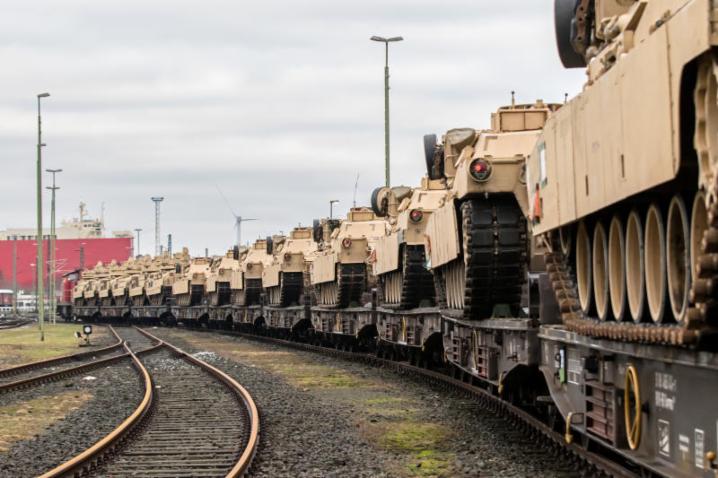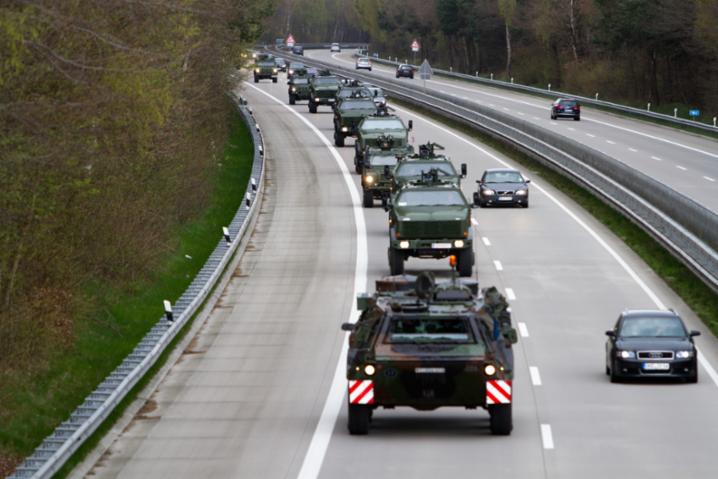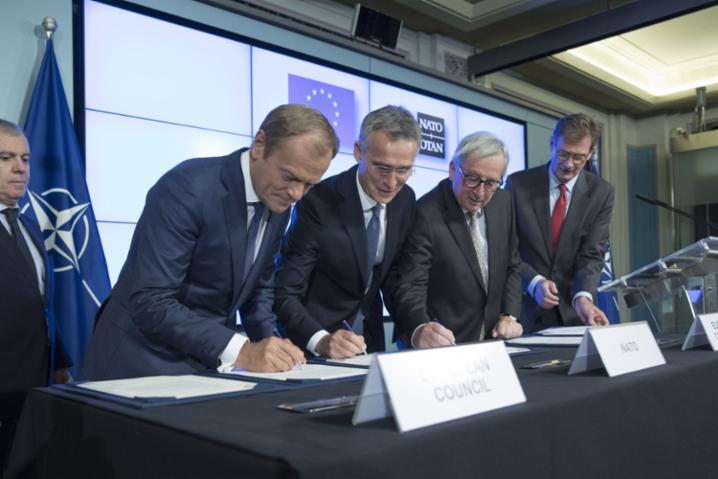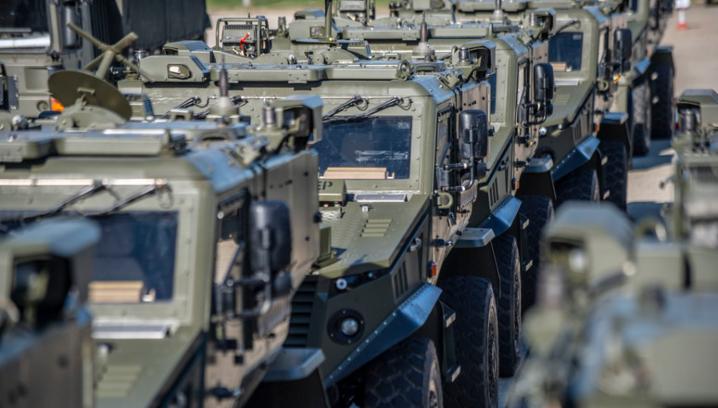The Joint Support and Enabling Command (JSEC) achieved initial operational capability on 17 September 2019. An important part of NATO’s increased deterrence and defence in response to a changed security environment, it will help to speed up, coordinate and safeguard the movement of Allied forces and equipment across European borders.
Along with its sister headquarters, Joint Force Command (JFC) Norfolk, the establishment of JSEC was endorsed by NATO’s defence ministers in February 2018. Where JFC Norfolk will help ensure sea lanes between North America and Europe remain safe, JSEC covers the so-called ‘rear area’ in Europe. A pivotal role in setting up JSEC was played by Germany, whose military posture and location as Europe’s logistical turntable made it the ideal ‘framework nation’. JSEC is part of the NATO Force Structure and under the operational command of the Supreme Allied Commander Europe (SACEUR). As a first step, JSEC will have approximately 280 staff (in peacetime). In a crisis establishment this figure will obviously be higher.

In a crisis situation, NATO’s new Joint Support and Enabling Command would help ensure the rapid deployment of reinforcement forces and military materiel across Europe, as required. © Bundeswehr / A. Bier
The rear area: a new challenge?
Since Russia’s illegal annexation of Crimea in 2014 and the rise of security challenges from the south, including brutal attacks by ISIS/Daesh and other terrorist groups, NATO has implemented the biggest increase in collective defence since the Cold War and adopted a 360 degree approach..
Commanders and planners realised that there was a gap in SACEUR’s area of responsibility. If, during conflict, a serious security incident occurred some 1000 kilometers behind the frontlines, who would be responsible for acting on it? Would it be SACEUR himself, or one of the two Joint Force Commands (Brunssum and Naples) within their Joint Operating Areas (JOA)? After all, they would be focused on military operations within their respective JOAs. A secure rear area, combined with the ability to rapidly reinforce troops, would allow both to concentrate on their core mission – warfighting – and also constitute a critical success factor for their operations.
Why is a new headquarters required for the rear area when none existed during the Cold War? There are three main reasons: military posture, geography and planning.
First, NATO’s military capabilities have been enormously reduced over the past 30 years. In contrast to the Allied posture during the Cold War, Allies currently maintain only a limited forward presence in the eastern part of the Alliance, measured in batallions rather than divisions. This means that readiness and the ability to rapidly reinforce troops – through the rear area – is an essential element of deterrence and defence.
Second, with the accession of NATO’s eastern members, the distances involved have multiplied. In the past, a U.S. Army convoy, for example, transitting from the port of Rotterdam to the West German border, had to travel about 500 kilometers and only had to cross one border. Now, to reach Tallinn, the distance is more than 2200 kilometers and includes five border crossings. In effect, during the Cold War many European countries were on or near the frontline; now many are far removed from it (both real and perceived).
Finally, during the Cold War, NATO planning for deployment and operations was comprehensive and precise. Tank batallions from Allied nations, for example, knew exactly where and how to deploy in West Germany in case of escalation. Routes were prepared, procedures were tested and everything was practiced regulary, such as in the NATO REFORGER (Return of Forces to Germany) exercises.
After the fall of the Berlin Wall and the disappearance of the Warsaw Pact, NATO headquarters were cut back and plans disappeared. NATO’s main focus turned to its out-of-area operations, such as in Afghanistan, which required a different kind of planning and logistics. Its missions were discretionary – at a time and place of the Allies choosing. Planning was tailored to the situation and equipment was simply put on commercial ships or flown in, sometimes even on contracted Ukrainian or Russian planes.
Back in Europe, new civilian infrastructure – such as roads and bridges – was built without incorporating any military considerations. This has not made moving a 60-tonne tank from A to B any easier. Now that NATO’s focus has reverted to the ability to rapidly respond to any threats to its territorial integrity, readiness is of paramount importance. Plans must therefore be ready for activation at the push of a button. Still, for logistical and planning aspects, NATO is relearning a lost art.
However, a simple comparison with the Cold War is misleading. With NATO's current 360 degree approach, regions traditionally not considered as the rear area may become so. Societies have fundamentally changed since 1989. States have privatised most of their critical infrastructure and connected almost everything to the Internet. New business efficiencies, such as just-in-time delivery, have cut out redundancy in many organisations and systems. Cyberspace offers a new and attactrative vector for malicious activities, and societies have only just started mapping the vulnerabilities and dependencies that have been created.
These vulnerabilities are a target for what is called ‘hybrid warfare’, encompassing covert operations that can include cyber attacks, disinformation campaigns, and sabotage. Most importantly, these malicious activities predominantly take place under the threshold of armed conflict; in other words, during peacetime. What was called civil preparedness during the Cold War is now covered – in part – by the broader term resilience (the ability to bounce back or rebound in crises) and necessitates a whole-of-government approach. Responding to all these novel challenges involves the art of learning something completely new.
JSEC’s twin pillars
JSEC´s core mission consists of two pillars: security and enablement. To address the gap in SACEUR’s area of responsibility, JSEC has a strong focus on security and force protection during crises, upon request of the sovereign nations.
A possible scenario in a crisis situation could involve a (host) nation lacking capacity to secure the reception and transit of incoming troops, either because its own forces have been committed to an operation or because it has limited military capacity to start with. This Ally could approach JSEC for assistance, which could then match demand to supply. Another option could be that JSEC, as a fully capable joint headquarters, could also have troops assigned under tactical command. Other scenarios could involve ensuring air cover for crucial locations or transport corridors.
Such scenarios would only occur during a crisis situation, where the North Atlantic Council would have to designate a (rear) area to JSEC and agree on an operational plan.
The second pillar of JSEC’s mission – enablement – is just as important. Enablement is a broad term, encompassing not only mobility, but also functionality. This includes all elements that facilitate and enhance transit to and from the Joint Operating Area(s).
Currently, Allied nations are responsible for transporting their own troops and equipment to the front. These complex movements are arranged through different bilateral agreements between sending-, transit- and host- nations. In a collective defence scenario (covered by Article 5 of NATO’s founding treaty), where a multitude of nations would transit military units to the Joint Operating Areas, this system would come under much pressure. For this reason, in recent years, European Allies have reduced bureaucratic formalities to speed up border crossing for forces and their equipment, and Allies have committed to shortening border crossing times to under five days.
Many nations lack the required military logistical capacity to transport their own troops (often a first victim of past defence cuts) and therefore rely on the same small pool of civilian transport companies. In a severe crisis, these companies would be overbooked, transport routes would become chokepoints and host- and transit- nations would be submerged in requests for assistance. Travel in the reverse direction, including military casualties or civilian refugees, could further complicate the situation. This is where JSEC would come in. Based on guidance from the Supreme Headquarters Allied Powers Europe (SHAPE), and in close coordination with other NATO entities, it would synchronise and prioritise Allied efforts in the rear area.

Coordination is essential to ensure that transport routes do not become chokepoints during military deployments in a severe crisis. © Bundeswehr / R. Alpers
Effective coordination is only possible if JSEC has an accurate and current situational overview/common operational picture. The foundations for this will have to be laid during peacetime; it would be too late to build this from scratch during a crisis. JSEC has already established a network of national single points of contact in most NATO nations and these will in turn permit a whole-of-government approach in their respective nations. JSEC will depend on data that Allies share, complemented with reliable open source information. Once constituted, a common operational picture will prove that the whole is more than the sum of its parts.
JSEC’s overview will allow it to advise SACEUR to prioritise units, deconflict travel arrangements or reroute transport convoys if necessary. Some of this would be done in close cooperation with the Standing Joint Logistics Support Group (SJLSG), which is a part of the NATO Command Structure and will be co-located with JSEC in Ulm in 2020. Although the exact delineation of tasks between JSEC and the SJLSG is not yet set in stone, a pipeline metaphor can be helpful: JSEC will build and protect pipelines leading to the operational areas, while the SJLSG determines what and how much flows through.
Training and exercises will be crucial for developing JSEC’s enablement function. In the past, exercises have made it clear that moving troops, equipment and ammunition across Europe’s frontiers is a slow and cumbersome affair. The former commander of the U.S. Army in Europe, Lieutenant General (ret) Ben Hodges, successfully campaigned for improvements in this field. In part to stimulate enablement within NATO, the United States has been a particularly strong supporter of JSEC. In times of crisis, after all, the United States’ military will be NATO’s fast mover and heavy lifter, providing enormous incoming military capacity. This will be practised next year, during a a major US exercise, DEFENDER-Europe 20. With 20,000 troops coming from the United States, it will be the largest deployment of U.S. Army forces to Europe (for an exercise) in 25 years. It will be the first opportunity for JSEC to observe and to learn how it can fulfill its coordinating role in the rear area.
NATO has also invested over two billion euros of NATO funding in military mobility projects over the last four years. This includes upgrading sea terminals with large fuel containers for Allied aircraft; building parking capacity for air-to-air refueling aircraft; and restoring runways for the use of Allied aircraft.
Several European initiatives are also important for JSEC’s enabling role. Mobility is now a a key focus of NATO cooperation with the European Union, which will ensure that civil and commercial transportation infrastructure, such as ports, roads and bridges, is up to the required standards to allow the transport of military forces and heavy materiel. A flagship of EU-NATO cooperation is the ‘Military Mobility’ project initiated by The Netherlands, which includes action points both in the logistical domain as in the legal/regulatory field. JSEC could assist with the implementation and operationalisation of these initiatives in training and exercises.

NATO and the European Union have identified military mobility as a key area for cooperation in the Joint Declaration signed in July 2018 by Secretary General Jens Stoltenberg and European Commission and Council Presidents Jean-Claude Juncker and Donald Tusk. © NATO
The road ahead
JSEC faces three main challenges on its path to full operational capability, planned for October 2021.
The first involves developing awareness among its stakeholders. Destined to be a central coordinating node in an international network, JSEC will have to show its added value to the Allies. When these actively support JSEC and provide it with relevant data, JSEC can in turn serve their interests more effectively.
The second concerns doctrine. NATO has recently successfully realigned its military strategy, and it goes without saying that the underlying documents are currently being finalized. Within this developing doctrinal context, JSEC is working alongside SHAPE to innovate and learn by doing.
Finally, JSEC will have to build a headquarters that combines two very different missions. Its primary peacetime task revolves around coordination and outreach, liaising with civilian and military stakeholders and developing a new system that provides a common operational picture of the rear area. The other, in preparation for crisis, concerns the establishment of an operational joint headquarters. Especially in a context where resources, although increasing, are still scarce, this will be a challenge.
For NATO, a secure rear area constitutes an important element of deterrence. The Alliance’s tailored operational and forward presence means that the ability to rapidly reinforce the frontline Allies is paramount. Within SHAPE’s priority of readiness, JSEC plays an important role in improving coordination and enablement. Some of this will involve rediscovering old lessons from the Cold War, other aspects will demand a new and original approach. In its path from initial to full operational capability, JSEC will continue to reach out to the Allies and coordinate closely with civilian and military stakeholders. Twenty-two of the 29 Allies are already actively engaged with JSEC, demonstrating the importance they attach to the rear area. By ensuring that this is secure and functional, JSEC will have NATO’s back.

